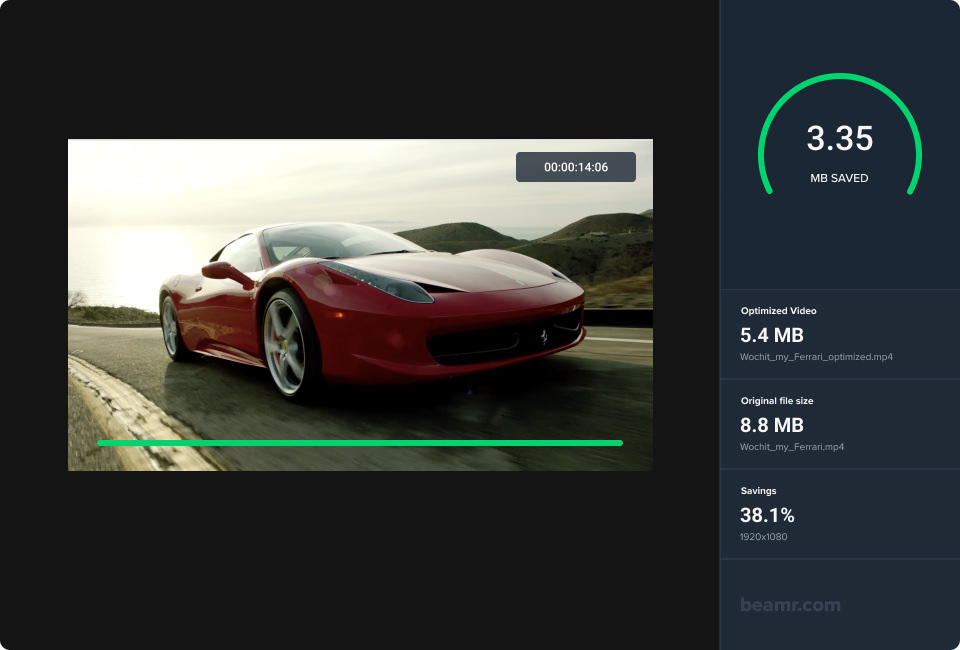Update 4/4/18:
Since the original publishing of this post, we’ve built a product page for the Beamr Transcoder VOD which may be viewed HERE.
The news of Beamr building a transcoder is spreading fast. Many are applauding the move and have expressed interest in adopting – but some may be wondering why a pioneering codec technology company feels the need to build a transcoder? Well, here’s the story.
Beamr was founded on a simple but technically complex idea that there are opportunities to deliver massive value to the video streaming and distribution ecosystem by guaranteeing the smallest video file and stream size possible without compromising video quality.
With the introduction of Beamr Video (now Beamr Optimizer), we proved that we could deliver an additional bitrate savings of up to 50% at the same quality. An incredible feat acknowledged by well-known streaming services and tier-one studios in Hollywood who adopted the technology for use in workflows including Blu-ray disc authoring which represents the highest pinnacle of direct-to-consumer quality.
By incorporating our perceptually driven optimization process (content-adaptive) into the codec, we enable MSO’s and streaming video delivery services to meet their objective of not delivering a single bit more than needed to represent the absolute quality they desire to transmit. This led us to acquire Vanguard Video in April 2016, a company providing codec engineering and software development services for many of the best-known video encoder OEM’s and streaming services. Now with our best-in-class codec, combined with our highly patented and well established perceptual optimization technology, we have the most advanced HEVC video codec in the market: Beamr 5x.
As a video codec does not function standalone outside of a lab environment, all Beamr Codec SDKs work inside the framework of FFmpeg through our plug-in interface. Through the development of our FFmpeg plug-in and as we surveyed the needs of our Telecom and MSO customers, it became clear that FFmpeg could not meet their requirements for industry-standard integration points such as SCTE-35 ad insertion.
What modern video services need in a transcoder.
To deliver uncompromising performance and system integration that meets our customer’s expectations, we built a transcoder that can enable new video workflow architectures with a value-added and performance-oriented engineering philosophy. The Beamr Transcoder is designed to work seamlessly in virtualized video encoding workflows and provides a full transcoding solution which includes Beamr codec SDKs: Beamr 4, Beamr 5, and Beamr 5x.
The first thing we recognized after talking with customers about what they were looking for in a transcoder is that the days of the monolithic black box “workflow solution” that includes content management, transcoding, packaging, DRM, etc. were over.
Customers were unanimous in reporting that they are tired of being held hostage by vendors.
Everyone said that they need a flexible media processing framework to fulfill the requirements of their video encoding service today and in the future.
We took this feedback as inspiration and adopted a critical design philosophy. The transcoder must satisfy the functional framework requirements to work in today’s containerized virtual computing and cloud environments while connecting to complementary solutions from any vendor.
Why FFmpeg isn’t enough.
A major performance advantage with Beamr codec SDKs is our multi-bitrate encoding capability. With multi-bitrate encoding, the SDK can share analysis information from the highest quality tier to the lowest bitrate tiers of the same picture size (resolution). This feature offers significant CPU and performance efficiencies, which allows the quality level to be dialed up for a given job, in a specified turnaround (processing) time. For anyone generating ABR profile stacks, Beamr’s multi-bitrate functionality is a game changer.
Today’s transcoder is a video processing framework that supports video codecs and the associated processing required for audio, metadata, etc. The performance advantages of Beamr’s H.264 and HEVC codec SDKs which ship inside the Beamr Transcoder start with much better parallelism (tiled encoding). Additionally, Beamr codec SDKs enable highly efficient CPU utilization on a many-core server and include better overall thread pool management.
Over the years as OTT workflows developed, many video distributors found FFmpeg as a media processing framework a good solution, but in time and as technical requirements and compatibility needs increased it has become less viable. FFmpeg is flexible, with many libraries and filters supporting container files and audio/video codecs. It also works with any video transformation during the transcoding process (decode – transform – encode): scaling function, frame rate conversion, color space conversion, bit depth conversion, filtering (noise reduction), etc.
Because the libraries and filters were developed separately, to make everything work in every combination needed, each filter must be run sequentially, passing the resulting uncompressed video frame to the next filter after it is ready. When the first processing step is complete, and the pixels or data needed for the next step are in the memory cache of the processor, it is more efficient to perform the following processing step immediately, as a tightly synchronized operation, all without saving the intermediate results to system memory, or disk. FFmpeg was developed asynchronously by hundreds and thousands of contributors, meaning this operational structure was not possible to build outside of a closely coordinated product roadmap, which by definition is lacking in open source projects.
Beamr Transcoder was built using a single thread pool that runs all processing tasks easily while outperforming FFmpeg as a media processing framework that runs multiple libraries with their own separate thread pool’s.
How we approached development of the Beamr Transcoder.
The Beamr Transcoder is lightweight, flexible, and not loaded down with legacy bloat. It may not meet a long laundry list of supported technologies, but, as service providers and OTT streaming services are shedding their legacy requirements in favor of lightweight, agile solutions that run 100% in software spanning virtualized environments, this is an advantage to the product. Designed for today’s video workflows, the Beamr Transcoder can scale across on-prem, public, private, or hybrid cloud infrastructures.
The heart of this highly efficient and flexible transcoder is an engine that was developed in native C++ to run on Linux while being highly scalable across public clouds such as AWS using Docker containers.

Beamr Transcoder VOD 1.0 features overview.
Beamr Transcoder is finely tuned and automatically allocates the optimal number of threads to the video encoding function, reserving the minimum needed for decoding, pipeline management, and network function control. Following is a summary of the critical capabilities of the first version of Beamr Transcoder VOD. (Beamr Transcoder Live will ship later in 2018)
– Containers: ES, TS, MP4, MOV
– Video Decoding: MPEG-2, ProRes, H.264, HEVC
– Video Encoding: H.264 (Beamr 4), HEVC (Beamr 5, Beamr 5x)
– Audio Encoding/Decoding: MP3, AAC, HE-AAC, HE-AAC+, AC-3, E-AC-3, AC-4
– 8, 10 and 12-bit color with 4:2:0/4:2:2
– Supports high resolution, high frame rate (HFR) up to 8Kp120
– SCTE-35 pass-through
– Encoding Boundary Points (EBP) support
– EIA 608/708 closed captioning
– Logo insertion
– Support for high dynamic range (HDR): HDR-10/HLG
Where we are going.
With Beamr Transcoder, Beamr’s HEVC & H.264 codec SDKs are now full video encoding solutions that can power your service to deliver the highest quality at the lowest bitrate possible. Like all Beamr solutions, the Beamr Transcoder has a fully committed road-map with the industries most reliable video technology engineering team executing it.
By leveraging Beamr’s video transcoder and the included encoding solutions, video encoding operations will operate as much as three times faster creating files that are up to 50% smaller.
To experience the performance of Beamr Transcoder which comes with an innovative business model that includes a free and premium version along with our highest rated HEVC and H.264 codec SDKs, send us an email to transcoder@beamr.com.
Visit beamr.com/transcoder to download the Beamr Transcoder VOD product information sheet or CLICK HERE for the product page.




